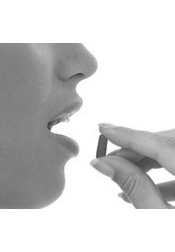Trikafta® tablet
This product is manufactured by Vertex Pharmaceuticals and is a combination of 3 ingredients, ivacaftor, tezacaftor, and elexacaftor.
This product is taken orally.

play
orally
Why is it prescribed?
Trikafta is used for the treatment of cystic fibrosis (CF) in patients 12 years of age and older who have at least one F508del mutation in the cystic fibrosis transmembrane conductance regulator (CFTR) gene.
This medication should always be taken with fat-containing food.
Swallow the tablets whole. Do NOT chew, break or dissolve the tablets.
Store at or below 30°C.
Alternatives
Other products that have the same ingredients as Trikafta® tablet are •Trikafta® granules ••Trikafta® granules ••Trikafta® granules •
See other products used in the treatment of •cystic fibrosis •
The recommended dose is:
- 2 to < 6 years:
- weighing < 14 kg: One packet of elexacaftor 80 mg/tezacaftor40 mg/ivacaftor 60 mg granules in the morning and one packet of ivacaftor 59.5 mg granules in the evening.
- weighing ≥ 14 kg: One packet of elexacaftor 100 mg/tezacaftor 50 mg/ivacaftor 75 mg granules in the morning and one packet of ivacaftor 75 mg granules in the evening.
- 6 to <12 years:
- weighing <30 kg: Two tablets, each containing elexacaftor 50 mg/tezacaftor 25 mg/ivacaftor 37.5 mg in the morning and one tablet of ivacaftor 75 mg in the evening (12 hours apart)
- weighing ≥30 kg: Two tablets, each containing elexacaftor 100 mg/tezacaftor 50 mg/ivacaftor 75 mg in the morning and one tablet of ivacaftor 150 mg in the evening (12 hours apart)
- ≥12 years:
- Two tablets, each containing elexacaftor 100 mg/tezacaftor 50 mg/ivacaftor 75 mg in the morning & one tablet of ivacaftor 150 mg in the evening (12 hours apart)
Various mutations of the cystic fibrosis gene block the "gates" that allow the flow of salt across the cell membranes. This causes mucus to become thick and clog the lungs. Ivacaftor is a "cystic fibrosis transmembrane conductance regulator (CFTC) potentiator". The CFTR protein is a channel at the surface of the cells that allows the movement of particles such as chloride in and out of the cell, contributing to salt and water balance. Ivacaftor helps this CFTR protein channel or "open the gates" more often allowing more salt to pass through. The thick mucus is reduced and cystic fibrosis symptoms lessen.
Various mutations of the cystic fibrosis gene block the "gates" that allow the flow of salt across the cell membranes. This causes mucus to become thick and clog the lungs. Tezacaftor is a "cystic fibrosis transmembrane conductance regulator (CFTC) corrector". The CFTR protein is a channel at the surface of the cells that allows the movement of particles such as chloride in and out of the cell, contributing to salt and water balance. Tezacaftor corrects the positioning of the CFTR protein on the cell surface to permit proper channel formation and improved flow of water and salts across the cell membrane. The thick mucus is reduced and cystic fibrosis symptoms lessen.
Various mutations of the cystic fibrosis gene block the "gates" that allow the flow of salt across the cell membranes. This causes mucus to become thick and clog the lungs. Elexacaftor is a "cystic fibrosis transmembrane conductance regulator (CFTC) corrector". The CFTR protein is a channel at the surface of the cells that allows the movement of particles such as chloride in and out of the cell, contributing to salt and water balance. Elexacaftor corrects the positioning of the CFTR protein on the cell surface to permit proper channel formation and improved flow of water and salts across the cell membrane. The thick mucus is reduced and cystic fibrosis symptoms lessen.
Contact your doctor if any of these side effects persists or are bothersome:
• Diarrhea
• Nausea
• Stomach (abdominal) pain
• Common cold
• Runny nose
• Upper respiratory tract infection
• Changes in the type of bacteria in your sputum
• Headache
• Dizziness
• Nasal congestion
• Sinus congestion
• Sore throat
• Rash
• Joint pain
Use with caution if you:
- have kidney or liver problems
- have cataracts
Possible drug interactions:
- ketoconazole, itraconazole, posaconazole, voriconazole, fluconazole
- some antibiotics such as clarithromycin, erythromycin, rifampin, rifabutin
- phenobarbital, carbamazepine, phenytoin
- midazolam, alprazolam, diazepam, triazolam
- digoxin
- cyclosporine, tacrolimus
- warfarin
- St. John’s wort
Use in pregnancy and breastfeeding. Little is known about the safety of this medication when used in pregnancy and breastfeeding. Consult your doctor or pharmacist before use.
